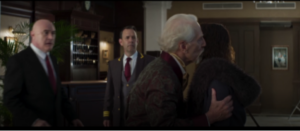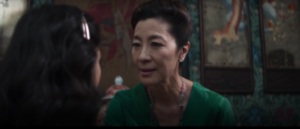82 Crazy Rich Asians (2018)
Socioeconomic Status and Race in Crazy Rich Asians
by (author prefers to remain anonymous)
Crazy Rich Asians (2018) is a romantic comedy film that tells the love story of native New Yorker Rachel Chu and her boyfriend Nick Young. After a year of dating, Rachel accompanies Nick back to his home in Singapore for his best friend’s wedding, where she is shocked to find that her boyfriend and his family are extremely wealthy. In addition to dealing with the crazy antics of the wealthiest of Singapore’s upper class, she must face Nick’s disapproving mother, Eleanor. Through instances of discrimination, culture, and the representation of Asians depicted in the film, Crazy Rich Asians explores the relationship between socioeconomic status and race.
In the first scene of the movie, Eleanor and her family are checking into a private hotel in London, but are met with discrimination by the hotel staff. The Young family is denied their suite by the hotel staff who deems them inadequate for the hotel and recommends they look for accommodations in Chinatown. However, after one phone call, the owner of the hotel, Lord Calthorpe, comes down to the lobby to greet the family and welcome them into their newly purchased hotel (0:02:40). The discrimination Eleanor faces points to the relationship between socioeconomic status and race, as well as the implications of the presence of wealth (Shaharudin, 2021). The hotel staff see that Eleanor and her family are Asian and assume that they cannot afford staying at a private hotel, implying the general assumption that Asians do not carry the wealth or exhibit qualities on par with Western culture that is “satisfactory” for the hotel. This scene establishes the social hierarchy in which those who have wealth also have the power to be used against those who are considered below them.

Because Eleanor exhibits wealth transferable to power, she is ultimately set apart from most of the characters including Rachel. Although Rachel teaches economics at the university level, Eleanor believes she lacks the wealth and power to marry her son and deems her as unworthy. Just as Rachel is looking for the bathroom in the Young house, Eleanor confronts her and tells her that she “will never be enough” (1:13:10). At this moment, the audience is met with a very close shot of the two characters in which Eleanor is looking down on Rachel from the top of the staircase. Thus, we realize that despite similarities in their culture and race, Eleanor and Rachel are set apart by the wealth and power they hold. Eleanor does not see Rachel as an equal but rather belonging to a lower class of people. This is an example of classism, a form of discrimination in which the socioeconomic status of an individual is taken into account. The interaction between Eleanor and Rachel relays that there can still be a division of class despite having similarities in culture and race.

There are other examples throughout the film that tackle the issues related to socioeconomic status and race. When Rachel visits her college roommate Peik Lin, she finds that her family lives in a large, gated house that is much like a palace. The exterior and interior of the house, as explained by Peik Lin’s mother, was inspired by the Hall of Mirrors in Versailles (0:31:08). The house is covered in marble and trimmed with gold complemented by Baroque style furniture and art. The audience also gets a wide shot of the dining room as Rachel eats lunch with Peik Lin’s family and there is even more decoration that speaks to royalty. Bouquets of roses and gold figurines line the background while on the dinner table are gold-plated dinnerware and drinkware encrusted with diamond to match the chandelier above. This display of upper-class wealth is the epitome of grand admiration for French royalty and a departure from what could be proper representations of Southeast Asian culture.
Colin and Araminta’s wedding party is another blatant display of wealth. The audience gets an aerial shot of the enormous party and it is a gaudy celebration reminiscent of parties seen in The Great Gatsby (2013). We see large round tables covered in flowers and lights facing a stage where there is a big band performing (1:29:11). The wedding guests, women dressed as flappers and men in tuxedos, are crowding the dance floor moving to the sound of swing jazz.

Swing music was most popular in the United States during the 1930’s and 1940’s and although most Americans enjoyed swing music, only white musicians and bandleaders received recognition for their music and performances (Saleh, 2021). As swing music was commercialized by a majority white musician population, a majority of white listeners tuned into the radio to enjoy the music. Thus, white Americans embraced swing music as if it were their own creation and that only they could enjoy such exciting music. Colin and Araminta’s wedding party is another example of classism and the standard that only the upper-class can enjoy music like swing music.
Not only does the film depict the wealthy as exuberant party goers, but also as dedicated Christians. In the film, any discussion of religion or religious practices are of Christianity as opposed to Buddhism or any other religion originating from Asia. The greatest example of this is when Eleanor is having a bible study session with family-friends. Eventually the group becomes sidetracked with talk of Nick bringing home Rachel (0:07:43). One of the women exclaims, “Oh I do hope she is a good Christian girl!” meaning that by being Christian, Rachel would share similar ideals and beliefs with not only Nick’s family but Eleanor as well. Further, this shows how Christianity, a Western religion, has become the gold standard of belief for religious followers, especially the upper class of Singapore depicted in Crazy Rich Asians.
Lastly, the representation of Asians still speaks to the cultural practices of the Western world despite the departure from typical Hollywood stereotypes. The audience gets a long shot of the bible study session in which Eleanor sits alone on the couch while the other women sit in their own single chairs (0:08:42). This is a visual representation of Eleanor’s upper-class status in which she is alone and that her family-friends do not exhibit the same wealth and power she does. Even before that, the audience also catches a glimpse of one of the servants of the Young household. As a servant, she is of the lower or working-class people in Singapore, which the film does not depict often. The film’s attention is solely on the wealthiest of the Singaporean population and is therefore not an accurate representation of Asians, let alone the city-state itself, which is diverse ethnically and religiously (Kang, 2018). The misrepresentation of Asians of the ‘Old Country’ caters to the average Hollywood viewer who is watching a movie truly based upon the glamorous life of Western aristocracy in the guise of Hollywood diversity.
For much of Hollywood’s history, the role of Asians in film has changed very little and they have been stereotyped to fit the image of how American society perceives Asians (Benshoff and Griffin, 2021). Crazy Rich Asians (2018) is the first movie in over a decade since the Joy Luck Club (1993) to star a majority Asian cast. Although the film is a better depiction of Asians in Hollywood, there are points where the film falls short. The film displays instances of culture clash and inherited wealth challenging what it means to be Asian and how that meaning is relative to where and how one lives. As a result, Crazy Rich Asians illustrates how wealth can determine one’s socioeconomic status, setting them apart from others within a population despite having a shared culture and racial experience.
References
Benshoff, Harry M., and Sean Griffin. America on Film: Representing Race, Class, Gender, and Sexuality at the Movies, Third ed., Wiley-Blackwell, Hoboken, New Jersey, 2021, pp. 130–149.
Kang, Inkoo. “Crazy Rich Asians Is Crazy, Rich, and Actually Very American.” Slate Magazine, 9 Aug. 2018, slate.com/culture/2018/08/crazy-rich-asians-the-movie-adaptation-reviewed.html.
Saleh, Leena. “The Swing Era: A Time of Hidden (Beauty and Limited) Oppression.” AOT, 26 June 2021, www.aotontario.org/post/the-swing-era-a-time-of-hidden-beauty-and-limited-oppression.
Shaharudin, Arshad. “Crazy Rich Asians, Racism and Classism.” Medium, 29 Mar. 2021, arshadshaharudin.medium.com/crazy-rich-asians-and-classism-eeec1931b749.

